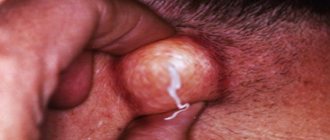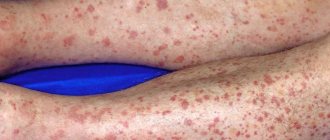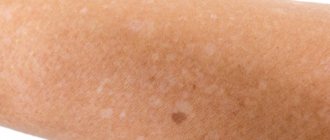- Purulent acne on the legs: causes
- Treatment of purulent acne on the legs
- Shaving hair and purulent acne on the legs: reasons
- Caring for your skin properly
- Expert advice
Purulent pimples, as usual, can also appear on the skin of the legs and in the area close to or near the groin, which in both women and men causes a lot of discomfort and can cause some embarrassment. Despite the fact that the skin of the legs is not very sensitive to external irritants, there are quite a lot of factors and reasons that in most cases cause a red rash or, in more severe cases, purulent acne on the legs. Before treating acne on the legs, of course, the root cause of the disease should be determined.
Purulent acne on the legs: causes
Purulent pimples on the surface of the skin of the legs can cause excessive irritation. Large subcutaneous formations occur especially often in parallel with hypothermia in humid and windy weather. The reason lies in the abundance of warm clothes on women’s legs, tights, underwear, trousers: the skin cannot fully function, as a result of which can't breathe and is constantly sweating.
The rash, as well as purulent pimples, consisting of numerous small papules, is the result of excessive exposure to sweat, especially in the hot season. This is the result of blocking the excretory pores of the sebaceous glands and inflammation that develops against this background. The skin looks red and swollen. It is also worth noting that purulent acne, unlike small pimples on the legs, can be seen much less frequently, since the skin is less sensitive to such inflammations.
But on the surface of the skin of the legs there can be both small watery pimples and, in more advanced and severe stages, purulent pimples, which can also appear as a result of close contact of the skin with the synthetic material of tights or boots.
An equally common cause of purulent pimples on the legs is hormonal imbalances in the body of a woman or man. In some cases, small or purulent pimples appear as a result of hormonal imbalance and poor functioning of the skin glands. Although the rash can appear not only on the inner thighs and legs, it can also appear on the pubis, buttocks, and lower back.
It is also worth noting that self-treatment of purulent acne can also be completely ineffective. To get rid of itchy problems, you need to consult with a dermatologist and immunologist to establish, first, the true causes of acne, and then move on to the procedures for their treatment. Rash, caused by seasonal vitamin deficiency, in most cases is similar to ordinary irritation from rubbing the skin against clothing.
In rare cases, acne on the legs is the result of prolonged colds or hypothermia of the legs.
Watery and purulent pimples on the skin of the legs and thighs usually appear in winter and autumn. Part of the rash is constantly hidden by clothing, so patients are in no hurry to begin the process of treating even purulent pimples on the legs, given that the problem is not too noticeable.
But in fact, the appearance of a papular purulent rash is a sign of more serious diseases in the body. In most cases, this is a sign of allergic reactions or manifestations of infection. Thus, watery papules will be a sufficient reason to visit a dermatologist. There is little benefit from self-medication, while the rash will take over more and more and more areas of the body.
Pimples on the inner thigh and groin area: this is a very painful type of acne that causes serious discomfort, since the skin in these areas is too thin and sensitive. Often the rash begins to itch and burn, and the rash also merges with conglomerates of ulcers. Pimples appear as a result of improper choice of underwear, allergies to washing powders, increased blood sugar levels due to the contagiousness of shellfish.
Purulent pimples on the legs may also indicate an infection, which can be “caught” in a sauna or swimming pool.
Genital herpes: the cause of extensive foci of a rash of purulent blisters in the groin and inner thigh and areas of the legs close to them Whatever the reasons lead to the formation of acne between your legs, you need to urgently consult a dermatologist or venereologist.
Acne on the outer surface of the foot: in this situation, consultation with a doctor should be immediate.
Thus, the rash is a sign of one of three diseases: dyshidrotic eczema, dyshidrosis or pruritic dermatitis.
What to do if the rash turns out to be acne?
If the appearance of the rash cannot be associated with depilation or ingrown hairs, you should consult a dermatologist. One of the reasons for the appearance of rashes on the body, including the legs, may be associated with blockage of the sebaceous glands and the development of acne. This disease is expressed in the appearance of comedones (open, closed), papules, pustules, nodules18.
Topical antibiotics can be used to combat acne18. This group of medicines includes Clindovit® gel. It contains clindamycin phosphate. After application of the gel to the skin, it hydrolyzes to form clindamycin, which exhibits antimicrobial activity against propionibacteria6. Clindovit® helps reduce free fatty acids on the skin from approximately 14 to 2%6.
Treatment of purulent acne on the legs
Poll: When did your acne appear? (Number of votes: 4295)
I've been suffering all my life
It's been a couple of years now
About a few months
Recently
To vote, click on the desired answer. results
Dermatologists recommend the use of salicylic acid preparations, usually this is a specific ointment that can be bought at any pharmacy. For severe superficial itching, the use of antibiotics may be prescribed. For example, Zenera or Dalacina. The attending physician and you, accordingly, should ensure that you do not exceed the dosage the chosen drug, which severely dries out the top layer of the skin. If the rash does not go away, and thus the skin becomes covered with dead skin flakes, then attempts at self-medication should be stopped and an urgent consultation with a doctor is necessary.
In pharmacies you can buy a tincture of calendula to treat the affected area, which can be used twice a day. Or mix equal proportions of acetylsalicylic powder and glycerin. This mixture is used to treat acne in the affected area several times a day, resulting in the composition clearing the skin.
You need to take vitamin A, which promotes rapid tissue regeneration. You can take a multivitamin complex or choose a retinol cream to treat purulent acne on the legs. However, the dose and course of treatment can only be prescribed by monitoring the reaction of your skin by a doctor.
Important: An overdose of vitamin A leads to dangerous consequences, such as thickening of the blood and bleeding.
A very effective method of ozone therapy, which in beauty salons helps women get rid of pustular purulent acne on the skin of the legs. This procedure is often combined with the use of various medications. Thanks to this procedure, the blood is oxidized, the body better absorbs dietary macroelements. Ozone therapy significantly accelerates the recovery of the skin after the effects of acne.
Causes of small pimples on legs
People with coarse, curly hair are more susceptible to ingrown hairs. Most often, the problem occurs after incorrect depilation. After shaving or removing hair with wax or sugar paste, its free edge bends and changes direction of growth. The resulting compaction is an inflamed infiltrate around the hair. The course of the inflammatory process can lead to the development of age spots, especially under the influence of solar radiation.
Small pimples on the legs after depilation and hair removal may appear for one of the following reasons:
- Sensitive skin. After hair removal, sensitive skin may develop a rash and redness.
- Violation of hygiene rules after hair removal. Hair removal affects the upper layers of the skin. Various bacteria can penetrate into it through microdamages, so it is important to properly treat your feet after the procedure.
- Individual skin reaction to a new procedure. If you previously used a machine, but have now switched to wax or sugar depilation, the skin may react to an unfamiliar effect with a rash or irritation.
- Allergy. Pimples on the legs can be an allergic reaction, for example, to the ingredients of wax or sugar paste.
Pimples can appear on the legs for other reasons, for example, due to acne. In this case, the culprits of the rash are the following50:
- Wearing clothes that are too tight. Tight clothes or constant rubbing of clothing on the skin could cause rashes.
- Endocrine disorders. Gynecological diseases, thyroid diseases.
- Nutritional factor. Eating foods rich in glucose, iodine, bromine, sucrose, etc.
- Use of cosmetics with comedogenic components. In some cases, mineral oils present in cosmetics can cause a rash.
- Taking certain medications, for example, glucocarticosteroids, cytostatics.
Any type of rash should alert you. The appearance of acne on the foot may be associated with one of the following diseases57:
- Dyshidrotic eczema. The pathology is associated with disruption of the sweat glands. Fluid accumulates under the skin, resulting in the formation of bubble elements. They are usually accompanied by itching, peeling, and pain. Opened blisters can become infected, which will worsen the course of the disease. The rash may first appear on the palms of the hands and then on the soles of the feet.
- Dyshidrosis. It occurs against the background of blocked sweat glands and increased sweating. It first appears in the form of blisters, which later turn into pustules. The rash itches and there is a burning sensation. The blisters may become inflamed and merge.
Shaving hair and purulent acne on the legs: reasons
Shaving and ingrown hairs are usually a female problem. Small and even purulent pimples on the legs often plague those who use a razor rather than professional tools and devices for shaving legs. To avoid these unpleasant consequences, it is necessary to change the razor every time. It is best if the device is equipped with a head with multiple floating blades that will protect the skin from minor wounds and protect against infections It is likely that hair removal using a razor is not suitable for a woman's specific skin type due to sensitivity and inherent dryness of the skin. In such a case, you should go for waxing or laser treatment.
But pimples after shaving are not as dangerous as ulcers that form at the site of hair growth. Firstly, there is a red inflamed relief, and then, the maturation of the purulent core, intense itching begins. Friction of clothing and scratching causes the penetration of pathogenic agents into the body, which leads to severe inflammation, bruising and swelling.
An effective natural remedy for Peppermint that quickly kills any acne!
Causes of the rash
Purulent acne on the legs of women , as well as some men, can appear for several reasons. Let's look at them.
Cosmetic procedures
One of the main reasons for the appearance of acne on the skin is improper skin care. Let's look at the most common mistakes
- Abundance of cosmetics . The modern market for body care products is literally overflowing with miraculous jars and bottles. They literally beg to be picked up, beckoning from store shelves. As a result, the skin suffers, which is scrubbed and moisturized daily. Naturally, you definitely need to take care of yourself, but you shouldn’t overdo it, because many products may not be combined with each other, causing irritation and rash. It is best to choose cosmetics from one line, preferably organic, as they are much safer than cosmetics filled with parabens. Moreover, the price of such goods is quite reasonable;
- Lack of skin care . There are girls who don’t see the point in taking care of the skin of their legs. But just like facial skin, it requires careful cleansing and moisturizing. It is especially worth paying attention to it in the winter season, when, in addition to the usual trousers, they also wear high boots. In such boots there is practically nothing for the skin to breathe.
- Depilation is one of the main reasons why acne appears on the legs. Almost every woman knows how to get rid of unwanted hair, but only a few know how to avoid causing irreparable damage to the skin. After depilation, the hair becomes thinner and grows into the skin, which is accompanied by bright redness and suppuration.
READ ALSO: Why Women Squeeze Pimples
Skin diseases
In addition to poor skin care, acne can occur due to various skin conditions. In this case, you should immediately consult a doctor. It can reveal:
- Dermatological diseases. If you lead a healthy lifestyle, do not overuse body cosmetics, do not use a depilator, but the red bumps on your legs haunt you, then you should not rule out skin diseases. It is better to immediately contact a specialist who will identify the cause of the disease and prescribe timely treatment;
- Infection. Many people who like to “pick themselves”, having once discovered a small pimple on their leg, will decide that they definitely need to squeeze it out. By doing this, it is very easy to cause an infection, getting in the future not just one harmless spot that can appear in anyone, but a whole bunch of pimples spreading all over the legs and buttocks;
- Hormonal disbalance. Often occurs in women with menstrual irregularities, during pregnancy or after childbirth. In this case, only a doctor after an examination can tell you how to get rid of acne on your legs.
Other factors
If a specialist has ruled out dermatological diseases, but pimples still appear, then you should watch how you dress and eat. Skin problems can also occur for other reasons, such as tight clothing and poor diet.
A person’s skin must breathe , but some representatives of the fairer sex literally do not take off their tight trousers or jeans, and many girls, due to the strict dress code at work, have to wear nylon tights even in the scorching heat. All this leads to clogging of pores, and pustules form. Being embarrassed by them, women can wear pants at home, which leads to even bigger problems;
Poor nutrition is the main cause of many skin diseases, including those on the legs. If the diet lacks all the necessary elements, and “food waste” replaces them, then you should not be surprised that the whole body is affected by acne.
Caring for your skin properly
It is necessary to control the temperature of the apartment in which you live. It is best if it does not exceed 22 - 23 C. Thus, you can regulate the process of sweating and reduce the secretion of apocrine glands. Excess sebum causes clogged pores. With sufficient attention to the microclimate in the room, symptoms of hyperhidrosis quickly will disappear This is important because acne is only the surface of the “iceberg” of problems; due to clogged pores, the body cannot get rid of accumulated toxins.
Avoid using chlorine agents to clean the bathroom and wash underwear, clothes and bedding. If acne appears on the skin of the legs, dermatologists recommend switching to hypoallergenic detergents, which are more expensive, but do not have the same effect on the skin.
If you have allergies, after shaving the skin of your legs can be treated with a scrub or lotion. You should not wear clothes made of synthetic fabrics, the skin stops breathing and self-cleanses.
Expert advice
If, despite all the efforts and measures for prevention and treatment, purulent acne still continues to occur and becomes a chronic problem, it is better to refuse self-medication and go to the clinic. First of all, an analysis will be taken - scraping the skin of the legs, a blood test will be prescribed and, a functional study may be carried out. There is a high probability that the rash is the result of diseases of the internal organs or the thyroid gland. Therefore, to treat this case, there should be no acne in the first place.
A rash on the skin of the legs can form in almost every person, regardless of gender or age. The causes of this problem are various provoking factors, increased sensitivity of the skin. And since these pimples are practically invisible to other people, many ignore the fact of their appearance. And this is a fundamentally wrong approach to to your health Any inflammatory suspicious skin lesion requires urgent treatment, because if the barrier function of the skin disappears, it will lead to serious disorders of the entire body, in addition to the area of acne-affected legs.











